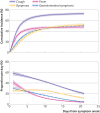Clinical spectrum of coronavirus disease 2019 in Iceland: population based cohort study
- PMID: 33268329
- PMCID: PMC7708618
- DOI: 10.1136/bmj.m4529
Clinical spectrum of coronavirus disease 2019 in Iceland: population based cohort study
Abstract
Objective: To characterise the symptoms of coronavirus disease 2019 (covid-19).
Design: Population based cohort study.
Setting: Iceland.
Participants: All individuals who tested positive for severe acute respiratory syndrome coronavirus 2 (SARS-CoV-2) by reverse transcription polymerase chain reaction (RT-PCR) between 17 March and 30 April 2020. Cases were identified by three testing strategies: targeted testing guided by clinical suspicion, open invitation population screening based on self referral, and random population screening. All identified cases were enrolled in a telehealth monitoring service, and symptoms were systematically monitored from diagnosis to recovery.
Main outcome measures: Occurrence of one or more of 19 predefined symptoms during follow-up.
Results: Among 1564 people positive for SARS-CoV-2, the most common presenting symptoms were myalgia (55%), headache (51%), and non-productive cough (49%). At the time of diagnosis, 83 (5.3%) individuals reported no symptoms, of whom 49 (59%) remained asymptomatic during follow-up. At diagnosis, 216 (14%) and 349 (22%) people did not meet the case definition of the Centers for Disease Control and Prevention and the World Health Organization, respectively. Most (67%) of the SARS-CoV-2-positive patients had mild symptoms throughout the course of their disease.
Conclusion: In the setting of broad access to RT-PCR testing, most SARS-CoV-2-positive people were found to have mild symptoms. Fever and dyspnoea were less common than previously reported. A substantial proportion of SARS-CoV-2-positive people did not meet recommended case definitions at the time of diagnosis.
© Author(s) (or their employer(s)) 2019. Re-use permitted under CC BY-NC. No commercial re-use. See rights and permissions. Published by BMJ.
Conflict of interest statement
Competing interests: All authors have completed the ICMJE uniform disclosure form at www.icmje.org/coi_disclosure.pdf and declare: no support from any organisation for the submitted work; no financial relationships with any organisations that might have an interest in the submitted work in the previous three years; and no other relationships or activities that could appear to have influenced the submitted work.
Figures



References
-
- World Health Organization. Pneumonia of unknown cause—China. 2020. https://www.who.int/csr/don/05-january-2020-pneumonia-of-unkown-cause-ch....
-
- World Health Organization. Coronavirus disease 2019 (COVID-19): situation report—51. 2020. https://www.who.int/docs/default-source/coronaviruse/situation-reports/2....
MeSH terms
LinkOut - more resources
Full Text Sources
Medical
Miscellaneous
